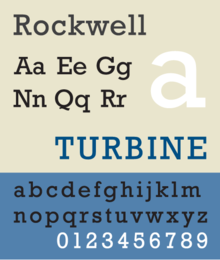Rockwell (typeface)
This article needs additional citations for verification. (December 2009) |
 | |
| Category | Serif |
|---|---|
| Classification | Slab serif |
| Foundry | Monotype |
| Date released | 1934 |
Rockwell is a serif typeface belonging to the classification slab serif, or Egyptian, where the serifs are unbracketed and similar in weight to the horizontal strokes of the letters. The typeface was designed at the Monotype foundry's in-house design studio in 1934.[1] The project was supervised by Frank Hinman Pierpont. Slab serifs are similar in form and in typographic voice to realist sans-serifs like Akzidenz Grotesk or Franklin Gothic. Rockwell is geometric, its upper- and lowercase O more of a circle than an ellipse. A serif at the apex of uppercase A is distinct. The lowercase a is two-story, somewhat incongruous for a geometrically drawn typeface.
Because of its monoweighted stroke, Rockwell is used primarily for display rather than lengthy bodies of text. Rockwell is based on an earlier, more condensed slab serif design called Litho Antique. The 1933 design for Monotype was supervised by Frank Hinman Pierpont.
The Guinness World Records used Rockwell in some of their early-1990s editions. Informational signage at Expo 86 made extensive use of the Rockwell typeface.[2] Docklands Light Railway also used a bold weight of this typeface in the late 1980s and early '90s. It is also used by the poetry publisher Tall Lighthouse for all their books, as well as on their website.[3]
The New York Times uses a similar typeface, Stymie Extra Bold, for the headlines and some other typographical uses in its Sunday magazine. The letterform of Stymie Extra Bold's lower-case "t" is highly geometrical, whereas Rockwell's Extra Bold has a rounded letterform. The ascender of the Rockwell "t" is also cut at a sharp angle not to be found in the Stymie typeface. The CW television network has used Rockwell in its on-air identity since 2009 in addition to Avant Garde Gothic.
The Charlotte Hornets used a variation of Rockwell called Rockwell Condensed for its logo and uniform typefaces.
References
- ^ Encyclopaedia of Type Faces (4th ed.). London: Blandford Press. 1970 [1953]. p. 194. ISBN 0-7137-0191-9.
{{cite book}}: Cite uses deprecated parameter|authors=(help) - ^ General Report on the 1986 World Exposition. Expo 86 Corporation, 1986, p. 115.
- ^ http://www.tall-lighthouse.co.uk/
